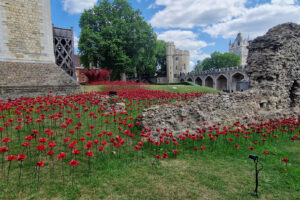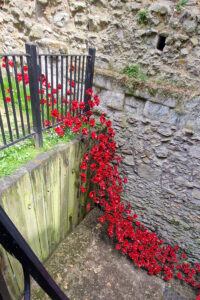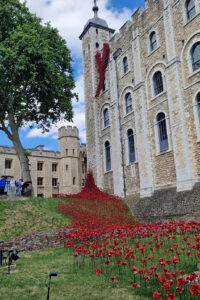The Poppies are back at the Tower of London! A smaller but poignant installation within the heart of the Tower to remember, to reflect and to commemorate the ending of the Second World War.
The original installation in 2014
In 2014 I was privileged to be one of the 21,688 volunteers to help with the installation of an art work at the Tower of London called Blood Swept Lands and Seas of Red better known as the Poppies at the Tower in memory of those who lost their lives in World War I. The artwork and name of the installation was inspired by a line from a Derbyshire serviceman who had described Flanders as “the blood-swept lands and seas of red where angels fear to tread.”
It was created by Paul Cummins and Tom Piper, and between July and November 2014 881,246 ceramic poppies gradually began to fill the moat, with the last poppy being planted by a 13-year-old cadet on the 11 November.
Each poppy represented a life lost from the Britain and the Commonwealth in World War I. The poppies were hand made in ceramic studios in the Midlands and each one was unique. The poppies encircled the Tower, with some cascading from the Tower window as if weeping, being – in the artists words -“transient and fragile like we are”.
The Evening Rituals
Each evening in the moat at sunset, names of 180 Commonwealth troops killed during the war were read out as part of a Roll of Honour, followed by the Last Post. Members of the public nominated names for the Roll of Honour using a weekly ‘first come, first served’ nomination system to be read the following week in this nightly ceremony.
The installation struck a chord with the nation with an estimated 5 million people coming to see them.
Poppies on tour
I was also one of the 8000 volunteers who helped to dismantle the installation with most of the poppies being sold to the public which helped to raise £8,000,000 for 6 charities.
Not all the poppies were sold however. Some 30,000 which made up the installations of the Wave and Weeping Window were gifted to the Imperial War Museum and these art works toured the UK and were reimagined in 19 different locations. They finally came home to the museum in 2018 so that the nation would always have a piece of the installation that had resonated with so many.
The Return in 2025
So, to 2025 and the Tower remembers. Those 30,000 poppies are now back at the Tower in a new installation – also designed by Tom Piper – to commemorate and celebrate 80 years since the ending of World War 2. The poppies cascade, pouring down from the top of the ancient White Tower spilling into the surrounding area, and then running down past the Wakefield Tower and coming out through Traitors Gate – a wound in the heart of the Tower.
The Tower in the Blitz
The Tower was not immune to suffering with several bombs dropping on it in the Blitz. Large sections of the Mint as well as a section of the old Hospital block were destroyed. Part of the Moat, main guard house and tower wharf were also damaged. But the most significant damage was caused on the 5thOctober 1940 when a bomb blew apart the North Bastion killing 70-year-old Yeoman Warder Samuel Reeve and Lily Frances Lunn who also lived there with her family.
This time a smaller group of volunteers planted 3000 of these poppies a day over 10 days and though I did not take part in this, it is a privilege to volunteer for Historic Royal Palaces at the Tower and to tell visitors about the installation.
The installation was officially opened by Her Majesty Queen Camilla with the last poppy being planted by the son of one of the Yeoman Warders to the Tower.
The poppies will remain at the Tower until the 11th November 2025.
The Significance of the Poppy
The countryside in Western Europe was bombed, blasted and fought over, turning it into mud, chaos and destruction. Into this bleakness the resilient little flower flourished and grew by the thousands. It moved and inspired a Canadian doctor, a Lieutenant Colonel John McCrae (who had lost a friend in Ypres at the sight of these poppies) to write the famous poem In Flanders Fields.
In Flanders fields the poppies blow
Between the crosses, row on row,
That mark our place: and in the sky
The larks, still bravely singing, fly
Scarce heard amid the guns below.
We are the dead. Short days ago
We lived, felt dawn, saw sunset glow,
Loved and were loved, and now we lie in Flanders fields.
Take up our quarrel with the foe.
To you from failing hands we throw
The torch; be yours to hold it high,
If ye break faith with us who die
We shall not sleep, though poppies grow
In Flanders fields.
And today the red poppy represents all those who lost their lives on active service, from the beginning of the First World War right up to present day. It also honours the contribution of civilian services and the uniformed services which contribute to national peace and security and acknowledges innocent civilians who have lost their lives in conflict and acts of terrorism.
……………………………………
To conclude: a sprinkling of poppy trivia
- There are more than 70 species of Papaver, the Latin Word for Poppy and it come in a range of shapes and colours to suit a range of gardens and planting styles.
- Its versatility is one of its strengths and just one of the many reasons why it such a popular garden flower.
- One of the most well-known species of poppy, Papaver somniferum, is the source of opium, a strong narcotic used in the production of opioids. However, it’s important to note that not all poppies produce opium.
- Poppy seeds are a natural source of opiates including opium, morphine and heroin. Accordingly, the drug morphine is named for Morpheus, the Greek god of sleep and dreams.
- The Roman god Ceres was also associated with poppy flowers.
- Poppy flower meaning has existed since ancient times. Poppies have long been associated with death, repose, and eternal sleep.
- Humans knew about opium’s effects as far back as the Neolithic era.
- Egyptian artwork also includes poppies. As a symbol of eternal life, poppies were depicted on artifacts buried with mummies.



